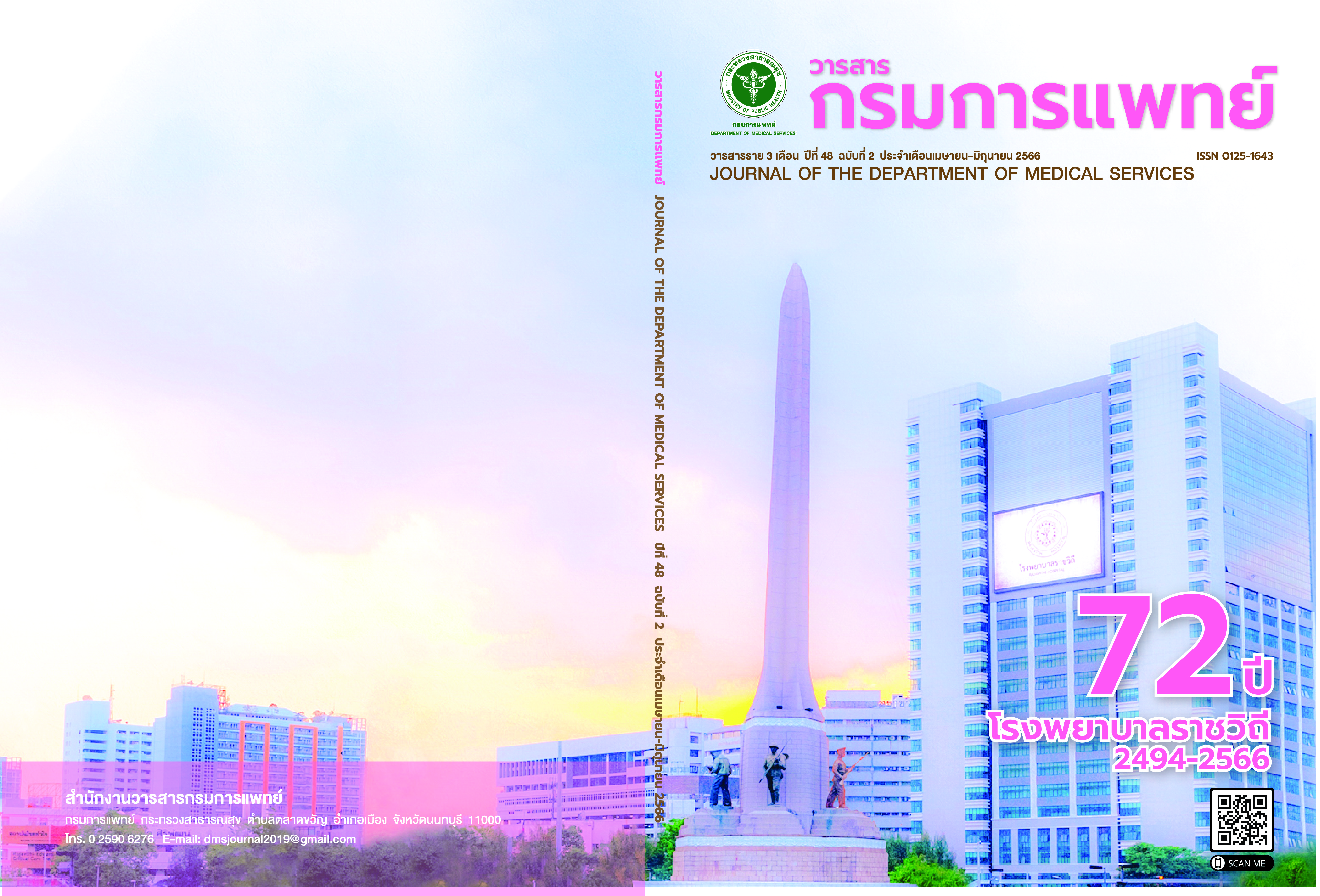Antimicrobial Resistance Situation of Healthcare-associated and Community-Acquired in Patients with Bloodstream Infections, Nopparat Rajathanee Hospital, 2018-2019
DOI:
https://doi.org/10.14456/jdms.2023.20Keywords:
Healthcare-associated bloodstream infection (HA-BSI), Community-acquired bloodstream infection (CA-BSI), Antimicrobial resistance (AMR)Abstract
Background: Antimicrobial resistance (AMR) is primarily found in hospitals and tends to steadily increase forvarious reasons. The World Health Organization prioritizes the the ESKAPE bacteria group, which includes Enterococcusfaecium, Staphylococcus aureus, Klebsiella pneumoniae, Acinetobacter baumannii, Pseudomonas aeruginosa,and Enterobacter spp. These bacteria are commonly found in hospitals for bloodstream infections (BSI), which can be community-acquired bloodstream infection (CA-BSI) from home or community, or healthcare-associatedbloodstream infections (HA-BSI) from hospitals. At present, there are no studies on community-acquired antimicrobialresistance compared to that in hospitals. Objective: The purpose of this research was to study the situation of ESKAPE bacteria antimicrobial resistance organisms identified in HA–BSI and CA-BSI patients, in order to developan AMR surveillance system, plan for appropriate treatment, care, and discharge for these patients. Methods: Thisretrospective study reviewed medical records of all hospitalized patients with at least one positive blood culturefrom recognized pathogens, from January 2018 to December 2019. The medical records were reviewed by infectioncontrol nurses (ICNs) using a standardized case report form. Results: 1,806 sample cases were analyzed, with gramnegative found in 77.8% of cases, compared to gram-positive bacteria. The ESKAPE bacteria antimicrobial resistanceorganisms were K. pneumoniae 40.6% (404/498), S. aureus 32.9% (164/498), and A. baumannii 10.0% (50/498),respectively. HA-BSI was found to have 18.4% MDR, 38.9% CRE, and 20.0%. VRE CA-BSI excluding POA was found tohave an MDR rate of 6.0% and CRE of 2.8%, while POA in CA-BSI had an MDR rate of 16.7% and CRE rate of 9.1%. Conclusion: Antimicrobial resistance is prevalent in both HA-BSI and CA-BSI; thus, it should be managed both inhospitals and communities, which includes people, animals, food, and agriculture, following the environment forone health model since there are many factors involved.
References
Thamlikitkul V. Handbook for prevention and control to antimicrobialresistance in hospitals. Health Systems Research Institute, ThaiHealthPromotion Foundation, Faculty of Medicine Siriraj Hospital, TheGovernment Pharmaceutical Organization, International DevelopmentResearch Center (IDRC), Canada; 2015: p. 120.
Centers for Disease Control and Prevention. About Antibiotic Resistance[cited 2020 Mar 10]. Available from: www.cdc.gov/drugresistance/about.html.
O’Neill J. Review on antimicrobial resistance. Tackling drug resistanceglobally; final report and recommendations; 2016:84.
Phumart P, Thamlikitkul V, Riewpaiboon A, Prakongsai P,Limwattananon S, Health and economic impacts ofantimicrobial resistance infections in Thailand; A preliminary study.J Health Systems Res 2012; 6:352-60.
Gandra S, Tseng KK, Arora A, Bhowmik B, Robinson ML, Panigrahi B, etal. The Mortality Burden of Multidrug-resistant Pathogens in India: ARetrospective, Observational Study. Clin Infect Dis 2018; 69(4):563-70.
Kristina E Rudd, Sarah Charlotte Johnson, Kareha M Agesa, Katya AnneShackelford, Derrick Tsoi, Daniel Rhodes Kievlan, et al. Global, regional,and national sepsis incidence and mortality, 1990-2017: analysis forthe Global Burden of Disease Study. Lancet 2020; 395(10219):200-11.
Laupland KB, Church DL. Population-based epidemiology andmicrobiology of community-onset bloodstream infections. ClinMicrobiol Rev 2014; 27(4):647-64.
Baharoon S, Telmesani A, Tamim H, Alsafi E, Aljohani S, MahmoudE, et al. Community- versus nosocomial-acquired severe sepsis andseptic shock in patients admitted to a tertiary intensive care in SaudiArabia, etiology and outcome. J Infect Public Health 2015; 8(5):418-24.
Viscoli C. Bloodstream Infections: The peak of the iceberg. Virulence2016; 7(3):248-51.
Bumrungsak R, Watagulsin P, Kasemsaisuwan A, Tantilipikara P,Sammanmit Y, Sawanpanyalert N. Surveillance for healthcareassociated bloodstream infections (HA-BSIs). J DMS 2018; 43(1):125-9
Lim C, Takahashi E, Hongsuwan M, Wuthiekanun V, Thamlikitkul V,Hinjoy S, et al. Epidemiology and burden of multidrug-resistantbacterial infection in a developing country. Elife 2016; 5:e18082.
Ziegler MJ, Pellegrini DC, Safdar N. Attributable mortality of central line associated bloodstream infection: systematic review andmeta-analysis. Infection 2015; 43(1):29-36.
Khumsri J, Tonkulrat W, Khuanped S, Wattanakul N, Aiumlaor P,Kiennukul N, et al. Bloodstream infection (BSI) surveillance incritical care units at Nopparatrajathanee Hospital, 2017. J DMS 2018;44(4):132-6
Attapornkusol P, Khumsri J, Khuanped S, Wattanakul N, Aiumlaor P, Tantilipikara P, et al. The Epidemiology of Bloodstream infection (BSI)in Nopparatrajathanee Hospital, 2020. J DMS 2020; 45(4):175-83
Sumpradit N, Suttajit S, Punpontrap S, Chuanchuen R, Prakongsai P.Landscape of antimicrobial resistance situation and action in Thailand.Bangkok: Aksorn graphic and design plublishing; 2015.
Centers for Disease Control and Prevention. National Healthcare SafetyNetwork (NHSN) Patient Safety Component Manual 2017.[Cited 2020Mar 05]. Available from: https://www.cdc.gov/nhsn/pdfs/pscmanual/pcsmanual_current.pdf.
Infection Control Committee for Helthcare associated infectiondiagnosis. Handbook for Helthcare associated infection diagnosis.Bamrasnaradura Infectious Disease Institute: Bangkok: Aksorn graphicand design plublishing; 2018: 62 p.
National Antimicrobial resistance Surveillance Center, Thailand.Antimicrobial resistance 2000-2021. [cited 2022 Dec 10]. Availablefrom: http://narst.dmsc.moph.go.th/
Khumsri J, Khuanped S, Tonkulrat W, Wattanakul N, Attapornkusol P,Aiumlaor P, et al. The Study of Antimicrobial Resistance (AMR) andESKAPE Bacteria Have Been Reported In –Healthcare AssociatedBloodstream Infections (HA-BSI) by WHONET Program in NopparatRajathanee Hospital, 2017-2018. J DMS 2020; 45(4):243-52
Downloads
Published
How to Cite
Issue
Section
License
Copyright (c) 2023 Department of Medical Services, Ministry of Public Health

This work is licensed under a Creative Commons Attribution-NonCommercial-NoDerivatives 4.0 International License.
บทความที่ได้รับการตีพิมพ์เป็นลิขสิทธิ์ของกรมการแพทย์ กระทรวงสาธารณสุข
ข้อความและข้อคิดเห็นต่างๆ เป็นของผู้เขียนบทความ ไม่ใช่ความเห็นของกองบรรณาธิการหรือของวารสารกรมการแพทย์



